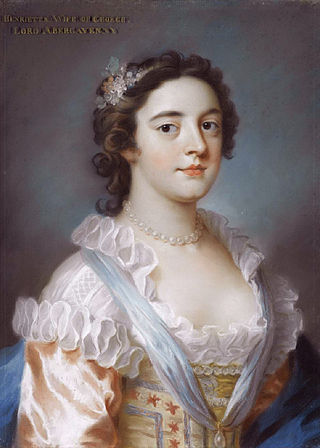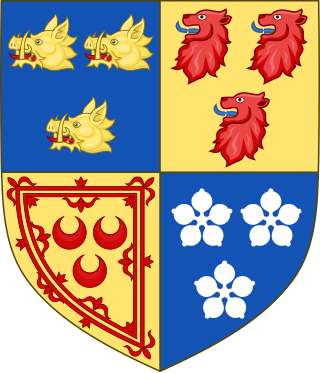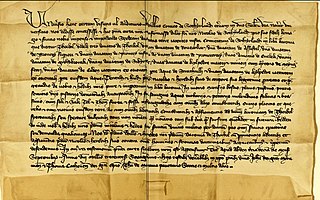Related Research Articles
Andrew Moray, also known as Andrew de Moray, Andrew of Moray, or Andrew Murray, was an esquire, became one of Scotland's war-leaders during the First Scottish War of Independence. Moray initially raised a small band of supporters at Avoch Castle in early summer 1297 to fight King Edward I of England. He soon had successfully regained control of the north for the absent Scots king, John Balliol. Moray subsequently merged his army with that of William Wallace, and jointly led the combined army to victory at the Battle of Stirling Bridge on 11 September 1297. In the fighting at Stirling, Moray was severely wounded. He died at an unknown date and place that year.

Sir Thomas Cheney KG of the Blackfriars, City of London and Shurland, Isle of Sheppey, Kent, was an English administrator and diplomat, Lord Warden of the Cinque Ports in south-east England from 1536 until his death.

Clan Seton is a Scottish clan which does not currently have a chief; therefore, it is considered an armigerous clan.

Clan Elphinstone is a Lowland Scottish clan.

George Nevill, 1st Earl of Abergavenny, known as Lord Bergavenny from 1744 to 1784, was an English peer. He married into a branch of the Pelham family seated at Stanmer and briefly held office as Lord Lieutenant of Sussex. Created an earl in 1784, he died the following year.

Alexander Seton, 1st Earl of Huntly, who adopted the family name of Gordon from about 1457, was a powerful 15th-century Scottish magnate. He was knighted in 1439/1440 and was Lord of Badenoch, Gordon, Strathbogie and Cluny.
Sir John Lauder of Fountainhall, 3rd Baronet was born 3 and baptised 5 December 1669 at Greyfriars Kirk, Edinburgh, Midlothian, Scotland. He died in February 1728 at Fountainhall manor, near Pencaitland, and was interred in the Lauder burial vault within Greyfriars. He succeeded his father John Lauder, Lord Fountainhall in the baronetcy in September 1722.

Henry le Chen [le Cheyn, le Chein, Cheyne, de Chene] was a late 13th-century and early 14th-century Scoto-Norman bishop. Hector Boece claims that he was the nephew of John III Comyn, Lord of Badenoch, but no contemporary evidence supports this. Cheyne belonged to a family with Norman roots which was well established in the northeast of Scotland, holding significant amounts of territory on the boundaries of the Earldom of Buchan.

Inverugie Castle or Cheyne's Tower is the ruins of a motte-and-bailey castle in Aberdeenshire, Scotland. It is a scheduled ancient monument.

Sir Edward Keith was a Scottish nobleman and hereditary 11th Marischal of Scotland.
Elizabeth Gordon, Heiress of Gordon, Scottish baroness and progenitress of the Gordon Earls and Marquesses of Huntly.
Alexander Seton, Lord Gordon was a Scottish baron, Lord of Parliament and progenitor of the Gordon Earls and Marquesses of Huntly.

The feudal barony of Plympton was a large feudal barony in the county of Devon, England, whose caput was Plympton Castle and manor, Plympton. It was one of eight feudal baronies in Devonshire which existed during the medieval era. It included the so-called Honour of Christchurch in Hampshire, which was not however technically a barony. The de Redvers family, first holders of the barony, were also Lords of the Isle of Wight, which lordship was not inherited by the Courtenays, as was the barony of Plympton, as it had been sold to the king by the last in the line Isabel de Redvers, 8th Countess of Devon (1237–1293).

Clan Cheyne is a Scottish clan. The clan is officially recognized by the Lord Lyon King of Arms, however as the clan does not currently have a chief recognized by the Court of the Lord Lyon, it is therefore considered an Armigerous clan. The surname Cheyne is also recognized as a sept of the Clan Sutherland, and is accepted as such by the Clan Sutherland Society in Scotland.
Sir Reginald le Chen or Cheyne (c.1235–1312) was a 13th-14th century Scottish noble. He was a sheriff of Nairn, sheriff of Inverness and Baron of Inverugie.
Sir Reginald le Chen of Inverugie and Duffus was a 13th–14th century Scottish noble. He was Baron of Inverugie and Duffus.
Sir Francis le Chen or Cheyne of Straloch was a 14th-century Scottish noble.
Sir Henry Seton Steuart FRSE LLD was a Scottish landowner, agricultural improver, soldier and classical scholar.
William Forbes, 7th Lord Forbes (1513-1593) was a Scottish landowner.

Nicholas Sutherland, 1st of Duffus was a Scottish noble who was seated at Duffus Castle, near Elgin, Moray, Scotland in the 14th and 15th centuries.
References
- ↑ Godsman, James (1958). A History of the Burgh and Parish of Ellon, Aberdeenshire. Aberdeen: Lindsay. p. 92.
- ↑ Henderson, Thomas Finlayson (1887). . Dictionary of National Biography . Vol. 10. p. 219.
- ↑ Taylor, Alice (2016). The Shape of the State in Medieval Scotland, 1124-1290. Oxford: Oxford UP. p. 433. Retrieved 11 October 2022.
- ↑ Copsey, Richard (1995). "The Carmelites in Aberdeen 1273-1560". Academia. 42. Retrieved 11 October 2022.
- ↑ Seton, Robert (1899). An Old Family: Or, The Setons of Scotland and America. New York: Brentano. p. 42. Retrieved 11 October 2022.
- ↑ Douglas, Robert (1813). The Peerage of Scotland (2nd ed.). Edinburgh. p. 1:351. Retrieved 11 October 2022.
- ↑ Literary and Scientific Association of Elgin (1858). Edward I in the North of Scotland. Elgin. p. 39. Retrieved 11 October 2022.
{{cite book}}: CS1 maint: location missing publisher (link)
- Graves, Robert. Good-bye to All That. p. 7